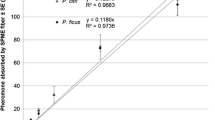Abstract
Migration of the males of nun moth was investigated on the area of 18 sq. km networked with 110 pheromone traps. After 24 hours the males, marked with different colours, were recorded at the distance of 280 m from the place of release and after 10–14 days they were found at a distance reaching even more than 3500 m. The marked specimens were captured still 24 days after release, which indicates that the males of the nun moth can live in the nature for almost a month.
Similar content being viewed by others
Literaturverzeichnis
Ambros, W., 1939: Vorsichts- und Schutzmaßnahmen gegen Nonnenkalamitäten mit besonderer Berücksichtigung der Bestandesleimung. Zbl. f. d. ges. Forstwes. 65.
Dyk, A., 1933: Dykova kontrola mnišky (Dyksche Nonnenkontrolle). Lesnická práce12, 25–28.
Hanno, K., 1938–39: Anlockversuche beiLymantria monacha L. Zt. ang. Ent.25.
Ferenzy, J.;Holzschuh, C., 1976: Der Sexualduftstoff Disparlure ein Helfer gegen die Nonne (L. monacha L.) All. Forstztg.87 (4), 109–112.
Jahn, E.;Lippay, H.;Weidinger, N.;Schwach, G., 1966: Untersuchungen über die Ausbreitung von Nonnenfaltern durch Markierung mit seltenen Erden. Anz. Schädlingskde. u. Umweltschutz39, 17–22.
Komárek, J., 1931: Minšková kalamita v létech 1917–1927 (Die Nonnenkatastrophe in den Jahren 1917 bis 1927). Sborník výzk. ústavů zeměd.78, 1–256.
Nolte, H. W., 1940: Neue Erfahrungen zur Dykschen Nonnenlockmethode. Zbl. f. d. ges. Forstwes.11–12, 198–206.
Skuhravý, V.;Hochmut, R., 1975: Fangergebnisse vonLymantria monacha L. (Lepid., Lymantriidae) bei Verwendung von verschiedenen Pheromon-Lockfallen. Anz. Schädlingskde, Pflanzenschutz, Umweltschutz49, 51–55.
Skuhravý, V.;Hochmut, R., 1976: Methodische Probleme des Fanges vonLymantria monacha L. (Lep., Lymantriidae) in verschiedenen Pheromon-Lockfallen. Anz. Schädlingskde., Pflanzenschutz, Umweltschutz49, 55–58.
Hochmut, R.;Skuhravý, V., 1977: The flight period of the nun mothLymantria monacha, investigated by pheromone traps. Acta. ent. bohemoslov.74, 65–68.
Hochmut, R.;Skuhravý, V.;Švestka, M., 1977: Kontrola bekyně mnišky (Lymantria monacha L.) feromonovými pastmi v období latence. Lesnictiví23, 265–286.
Author information
Authors and Affiliations
Additional information
Mit 2 Abbildungen
Rights and permissions
About this article
Cite this article
Skuhravý, V., Zumr, V. Zur Migration der Nonnenmännchen (Lymantria monacha L.), untersucht durch Markierung und Fang an Pheromon-Lockfallen. Anz. Schadlingskde., Pflanzenschutz, Umweltschutz 51, 39–42 (1978). https://doi.org/10.1007/BF01903216
Issue Date:
DOI: https://doi.org/10.1007/BF01903216




